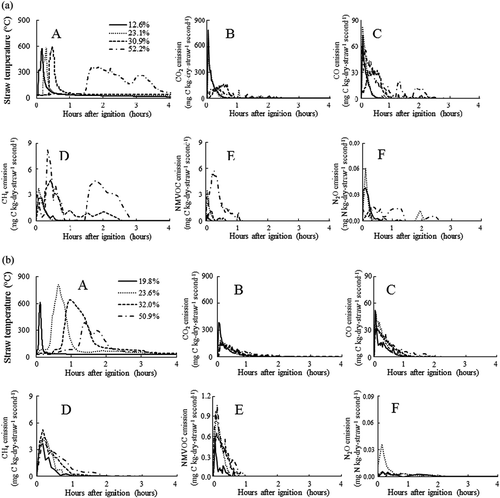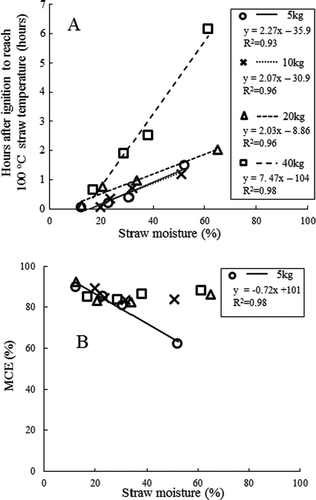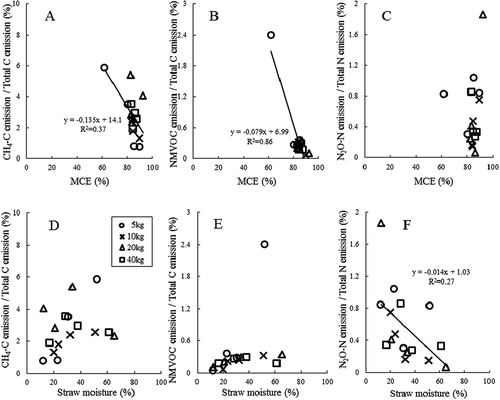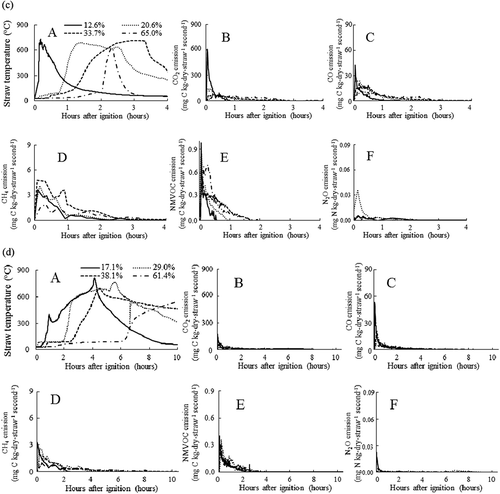Figures & data
Table 1 Ignition loss of carbon (C) and nitrogen (N) at each straw burning condition (straw of Jasmine 85 harvested in February 2012)
Figure 1 Straw stack dynamics: (A) internal temperature and (B) emission factors of carbon dioxide (CO2), (C) carbon monoxide (CO), (D) methane (CH4), (E) non-methane volatile organic carbon (NMVOC) and (F) nitrous oxide (N2O) during the combustion of (a) 5 kg, (b) 10 kg, (c) 20 kg and (d) 40 kg (oven-dried weight) straw stacks with different moisture contents (12.6, 23.1, 30.9 and 52.2%; mass basis).

Table 2 Greenhouse gas emissions derived from straw burning. Emission factors are expressed as the amounts of carbon (C) or nitrogen (N) emitted per 1 kg oven-dried weight of straw or mushroom beds. Values in parentheses show relative gas emission per calculated C or N loss
Figure 2 Correlations between straw moisture content (x) and (A) hours after ignition to reach a 100°C straw stack internal temperature; (B) modified combustion efficiency (MCE). Lines of significant regressions are given for straw stacks with different masses (5, 10, 20 and 40 kg dry straw; p < 0.05, n = 4 each).

Figure 3 Correlations between straw moisture content or modified combustion efficiency (MCE) and emission ratios of (A, D) methane (CH4), (B, E) non-methane volatile organic carbon (NMVOC) and (C, F) nitrous oxide (N2O) per calculated carbon (C) or nitrogen (N) loss (mass basis). Solid lines of significant regressions are given (p < 0.05, n = 16).

Table 3 Carbon (C) and nitrogen (N) contents in straw immediately after being harvested from rice paddies, straw after straw-mushroom [Volvariella volvacea (Bul. ex Fr.) Singer] cultivation, harvested straw-mushroom and ash of straw that was used for straw-mushroom cultivation as mushroom beds and then burned. Contents of carbon and nitrogen are expressed as the amounts of C or N contained in 1 kg of oven-dried straw (n = 3, mean ±standard deviation)
Table 4 Carbon (C) and nitrogen (N) emitted from straw-mushroom (Oryza sativa L.), cultivation. Emission rates are expressed as the amounts of C or N emitted per 1 kg oven-dried weight of straw
Figure 4 Dynamics of (A–C) carbon dioxide (CO2), (D–F) methane (CH4) and (G–I) nitrous oxide (N2O) emitted by microbial decomposition of mushroom beds during straw-mushroom [Volvariella volvacea (Bul. ex Fr.) Singer] cultivation, which is conducted with straw harvested in (A, D, G) winter–spring, (B, E, H) spring–summer and (C, F, I) summer–autumn rice cropping seasons. Error bars show standard deviations (n = 3).
![Figure 4 Dynamics of (A–C) carbon dioxide (CO2), (D–F) methane (CH4) and (G–I) nitrous oxide (N2O) emitted by microbial decomposition of mushroom beds during straw-mushroom [Volvariella volvacea (Bul. ex Fr.) Singer] cultivation, which is conducted with straw harvested in (A, D, G) winter–spring, (B, E, H) spring–summer and (C, F, I) summer–autumn rice cropping seasons. Error bars show standard deviations (n = 3).](/cms/asset/8769d103-8d62-47ae-9364-0604ed6117e1/tssp_a_1041862_f0005_b.gif)
Figure 5 Greenhouse gas emissions derived from straw-use [(A) straw burning and (B) straw-mushroom [Volvariella volvacea (Bul. ex Fr.) Singer] cultivation] from different straw stack masses, and their moisture contents (moisture contents of burned mushroom beds were 16% in the winter–spring season, 17% in the spring–summer season and 22% in the summer–autumn season). Each gaseous species’ emissions factor was integrated with respect to each direct and indirect global warming potential [1.0 for carbon dioxide (CO2), 1.9 for carbon monoxide (CO), 25 for methane (CH4), 0.81-7.47 for non-methane volatile organic carbon (NMVOC], and 298 for N2O; mass basis referring to IPCC Citation2007). Error bars illustrate the ranges of the NMVOC’s global warming potential.
![Figure 5 Greenhouse gas emissions derived from straw-use [(A) straw burning and (B) straw-mushroom [Volvariella volvacea (Bul. ex Fr.) Singer] cultivation] from different straw stack masses, and their moisture contents (moisture contents of burned mushroom beds were 16% in the winter–spring season, 17% in the spring–summer season and 22% in the summer–autumn season). Each gaseous species’ emissions factor was integrated with respect to each direct and indirect global warming potential [1.0 for carbon dioxide (CO2), 1.9 for carbon monoxide (CO), 25 for methane (CH4), 0.81-7.47 for non-methane volatile organic carbon (NMVOC], and 298 for N2O; mass basis referring to IPCC Citation2007). Error bars illustrate the ranges of the NMVOC’s global warming potential.](/cms/asset/7b7d71e7-7a53-4b39-a66b-cc842a18f9e8/tssp_a_1041862_f0006_b.gif)
Table 5 Straw production, amount of harvested straw, its use and greenhouse gas emissions from the harvested straw-use in a triple rice (Oryza sativa L.) cropping system of Tan Loi 2 hamlet, Thot not, Can Tho city, Viet nam from 2007 to 2011

